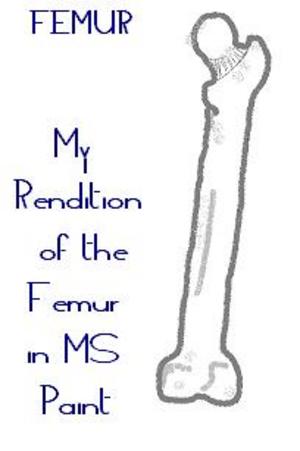The human femur is the upper leg bone between the hip and the knee, and is the strongest, longest, and most voluminous bone in the human body. The upper portion of this bone forms part of the hip joint, the acetabulum. The lower portion forms part of the knee (patella) joint. It’s a long bone similar to the upper arm bone known as the humerus. According to medterms.com, the “word ‘femur’ is the Latin word for thigh and the femur is familiarly known as the thigh bone.”
Long bones such as the femur assist our body by developing red blood cells in its marrow. Red blood cells help deliver oxygen all over our body. It also stores minerals and nutrients such as iron, calcium, and other necessary trace elements.
Parts of the Femur
There are certain parts to every bone, called landmarks or bony landmarks. These help distinguish where certain muscles are located and attach and are very helpful for massage therapists, physical therapists, orthopedic surgeons, and other professions that need to know where specific regions are located with respect to a bone or muscle.
The proximal portion (that closest to the body) of the femur includes the head, femoral neck, greater and lesser trochanter, intertrochanteric line, and intertrochanteric crest. The body of the femur forms the shaft (diaphysis) and includes the linea aspera, gluteal tuberosity, and the pectineal line. Moving further down are the medial and lateral supracondylar ridges. Finally, the distal part (area furthest away from the body) features the adductor tubercle, the medial and lateral condyles and epicondyles, the epicondylar fossa, and the patellar surface.
Muscles Located in the Thigh Region
The quadriceps are composed of four muscles on the anterior (front) of the femur: vastus medialis, vastus intermedius, vastus lateralis, and the rectus femoris. The quadriceps help straighten the knee (flexion) and leg extension. The quadriceps help in extending the knee and also serve as a hip flexor.
The hamstrings are located posteriorly (on the back) on the femur bone and features the biceps femoris (long head and short head), semitendinosus, and semimembranosus. They aid in knee flexion, external and internal rotation of the knee, and hip extension.
Other muscles include the pectineus, sartorius, gracilis, quadratus femoris, adductor longus, adductor brevis, and adductor magnus. In addition, there are pelvic muscles that act on the femur including iliacus, psoas major, tensor fasciae latae, gluteus maximus, gluteus minimus, and the gluteus medius.
Fractures
Fractures of the femur can cause significant disability. Femur fracture patients are often put into traction to reduce the pulling of muscles on bony fragments. Surgery is an option with the insertion of rods and screws and is most often successful at recovering full range of motion. Weight-bearing after surgery is recommended to be delayed to facilitate proper bone healing. Casts are not usually applied to the thigh, but more commonly rods, screws, and internal devices are used. According to orthopaedia.com, “Complications with the surgery can include: articular sepsis, arthritis, knee stiffness.”
In Summary
The femur is a very important bone of the body. It assists with many movements (including the walking process), houses many muscles, bears much body weight, and even helps produce blood cells. It may look like a plain and simple bone, but there is much more to it than it’s “simplicity!”
Sources
http://www.orthopaedia.com/display/Main/Femur+Bone
http://www.courses.vcu.edu/DANC291-003/unit_6.htm
http://www.pediatric-orthopedics.com/Topics/Bones/Femur/femur.html
http://www.uchsc.edu/sm/chs/ngi/assets/asset_femur.html
http://www.getbodysmart.com/ap/muscularsystem/menu/menu.html
http://www.medterms.com/script/main/art.asp?articlekey=3407
http://www.wisegeek.com/what-are-quadriceps.htm
http://www.exrx.net/Muscles/Hamstrings.html
http://www.apatech.com/patient/us.asp
